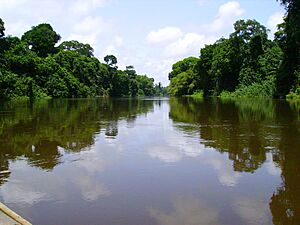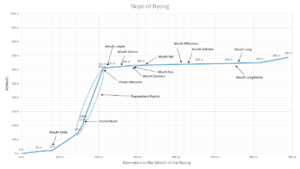Nyong River facts for kids
Quick facts for kids Nyong river |
|
|---|---|

Nyong River
|
|

The Nyong River in Cameroon
|
|
| Other name(s) | Yong |
| Country | Cameroon |
| Regions | Littoral Region, East Region, South Region, Centre RegionCentre Region |
| Cities | Abong-Mbang, Mbalmayo |
| Physical characteristics | |
| Main source | Near Abong-Mbang 690 m (2,260 ft) 3°52′00″N 13°28′00″E / 3.86667°N 13.46667°E |
| River mouth | Bight of Biafra 0 m 3°15′39″N 9°54′16″E / 3.26083°N 9.90444°E |
| Length | 690 km (430 mi) |
| Basin features | |
| River system | Nyong River |
| Basin size | 27,800 km2 (10,734 sq mi) |
| Population | 1,179,200 |
| Tributaries |
|
| Waterfalls | Trappenbeck Rapids |
The Nyong River is a major river located in the country of Cameroon in Africa. It used to be called Yong. This river flows for about 690 kilometers (that's about 429 miles) before it reaches the Gulf of Guinea.
Contents
Where the River Flows
The Nyong River starts about 40 kilometers (25 miles) east of a town called Abong-Mbang. This area is a northern rainforest, which provides a lot of water to the river.
River's Path and End
The Nyong River flows mostly in the same direction as the lower part of the Sanaga River. The Nyong ends in a place called Petit Batanga. This spot is about 64 kilometers (40 miles) south-southwest of another town, Edéa.
Along its path, the Nyong River has some big, fast-moving sections called rapids. You can find these rapids near the towns of Mbalmayo and Déhané.
Even with the rapids, parts of the river are used for travel. Small boats can use the first 400 kilometers (250 miles) of the river, between Abong-Mbang and Mbalmayo. This is usually possible from April to November.
River's Water Flow
Scientists measure how much water flows in the Nyong River. At a place called Déhané, they measure the flow in cubic meters per second (m³/s). This helps them understand the river's health and how it changes throughout the year.
Towns Along the River
Several towns are located along the Nyong River, making it an important waterway for the people living there.
Key Towns
- The town of Mbalmayo is on the north side of the river. It also has a railhead, which is a place where a railway line ends or begins.
- Other important towns on the river include Akonolinga and Abong-Mbang.


